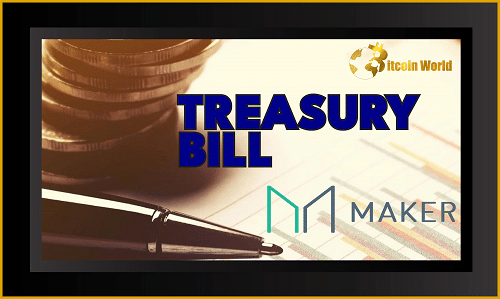In a surprising turn of events, the often-discussed rivalry between Traditional Finance (TradFi) and Decentralized Finance (DeFi) seems to be taking a collaborative twist. MakerDAO, a leading DeFi protocol, is making headlines with its bold move to navigate the ongoing crypto bear market. How? By strategically investing a significant portion of its reserves into the very instruments championed by TradFi: US Treasuries and Bonds.
Yes, you read that right! The Decentralized Autonomous Organization (DAO) governing MakerDAO has put forth a signal request that could pave the way for a substantial $500 million investment. The proposed allocation? A blend of 80% in US government treasuries and 20% in bonds. This isn’t just a minor portfolio tweak; it’s a potential paradigm shift in how DeFi protocols manage their assets and interact with the traditional financial world.
Why this move, and why now? DAI, MakerDAO’s decentralized stablecoin, has been feeling the chill of the bear market, like much of the crypto sphere. To bolster its reserves and generate yield in these turbulent times, MakerDAO is turning to time-tested investment vehicles. This initiative, driven by community voting, signals a pragmatic approach to weathering the storm and potentially setting a new precedent for DeFi protocols.
What Does MakerDAO’s Decision Mean For The Crypto Space?
To understand the significance of MakerDAO’s decision, we need to look at the broader economic landscape. As many analysts predict, the Federal Reserve (Fed) is expected to continue its path of raising interest rates throughout the year. These interest rate hikes have a ripple effect. They make borrowing more expensive for corporations, often leading them to shed riskier assets to manage their loan obligations. In simple terms, when interest rates go up, the cost of doing business increases.
This environment creates a challenging scenario for the crypto market. Investors and traders tend to become risk-averse, pulling funds out of volatile assets like cryptocurrencies and seeking refuge in perceived ‘safer havens’ such as bonds and debentures. This shift in investor sentiment can exert further downward pressure on crypto prices, potentially leading other crypto protocols to consider similar strategies to MakerDAO. Why? Because preserving capital and generating yield in a low-growth or recessionary environment becomes paramount.
Let’s break down the potential implications:
- Validation of TradFi Instruments: MakerDAO’s move could be seen as a tacit acknowledgment of the stability and reliability of traditional financial instruments like US Treasuries, even within the DeFi space.
- Shift in DeFi Strategy: It might signal a broader trend where DeFi protocols diversify their treasury management strategies beyond purely crypto-native assets, especially during bear markets.
- Reduced Volatility for DAI?: By generating yield from less volatile assets, MakerDAO could potentially strengthen the DAI peg and improve its overall stability.
- Attracting Institutional Interest?: This bridge between DeFi and TradFi could make DeFi protocols more appealing to institutional investors who are comfortable with traditional asset classes.
However, it’s crucial to maintain perspective. While this move is noteworthy, it doesn’t necessarily indicate an exodus from crypto or a lack of faith in DeFi’s long-term potential. Instead, it can be interpreted as a mature and pragmatic approach to risk management and treasury diversification within the DeFi ecosystem.
The Way Forward: Is This a Long-Term Trend?
While the Fed’s aggressive stance on interest rates is a current reality, it’s unlikely to be a permanent state. Sustained high interest rates can have detrimental effects on economic growth. They can stifle business activity, make investments less attractive, and ultimately lead to a dip in employment generation. The Fed closely monitors economic indicators, particularly the employment index. If employment figures start to weaken significantly, the pressure to ease monetary policy and potentially lower interest rates will increase.
Therefore, MakerDAO’s $500 million investment should not be interpreted as a fire sale or a sign of impending liquidation within the crypto market. As Sebastien Derivaux, from MakerDAO’s Strategic Finance Core Unit, aptly stated, “An investment of 500M DAI in this context, that is expected to remain liquid and low volatility, is therefore not a significant risk for the DAI peg nor the solvency of MakerDAO.” This statement underscores the strategic and calculated nature of the move, aimed at optimizing yield and managing risk, rather than a distress signal.
Key Takeaways:
- Strategic Diversification: MakerDAO’s investment in US Treasuries and Bonds is a strategic diversification move to generate yield and manage risk during the bear market.
- Pragmatic Approach: It highlights a pragmatic approach within DeFi, acknowledging the value of traditional financial instruments for treasury management.
- Not a Sign of Capitulation: This is not necessarily a sign of DeFi capitulating to TradFi, but rather a potential integration and collaboration between the two worlds.
- Potential Trendsetter: MakerDAO’s decision could influence other DeFi protocols to consider similar diversification strategies.
- Focus on Sustainability: Ultimately, this move reflects a focus on the long-term sustainability and resilience of DeFi protocols in the face of market volatility.
In conclusion, MakerDAO’s foray into US Treasuries and Bonds is a significant development that warrants close attention. It represents a potentially transformative moment in the evolution of DeFi, signaling a willingness to bridge the gap with TradFi for strategic advantage and long-term stability. Whether this becomes a widespread trend remains to be seen, but it undoubtedly opens up new avenues for how DeFi protocols navigate market cycles and manage their growing treasuries. The amicable rivalry between TradFi and DeFi might just be paving the way for a more integrated and robust financial future.
Disclaimer: The information provided is not trading advice, Bitcoinworld.co.in holds no liability for any investments made based on the information provided on this page. We strongly recommend independent research and/or consultation with a qualified professional before making any investment decisions.


